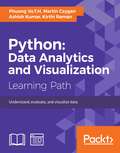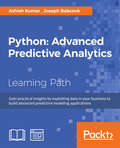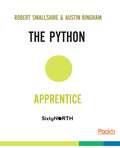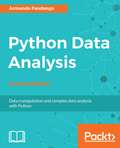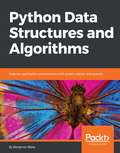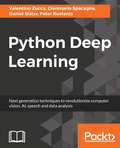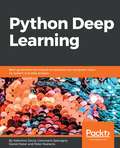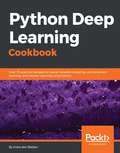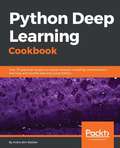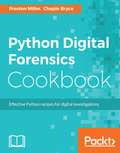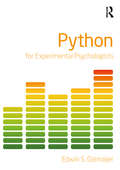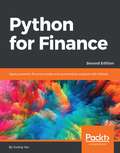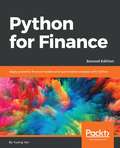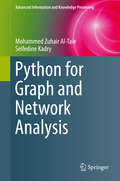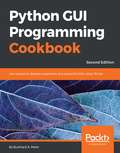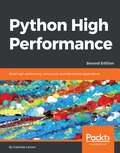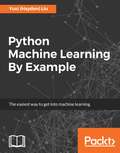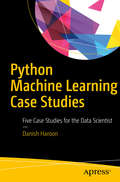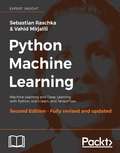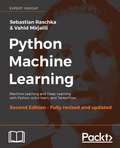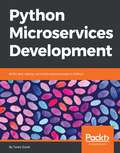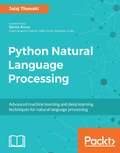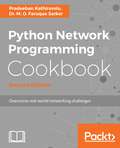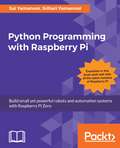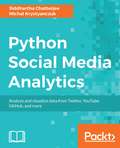- Table View
- List View
Python: Data Analytics and Visualization
by Phuong Vo.T.H Martin Czygan Kirthi Raman Ashish KumarUnderstand, evaluate, and visualize data About This Book • Learn basic steps of data analysis and how to use Python and its packages • A step-by-step guide to predictive modeling including tips, tricks, and best practices • Effectively visualize a broad set of analyzed data and generate effective results Who This Book Is For This book is for Python Developers who are keen to get into data analysis and wish to visualize their analyzed data in a more efficient and insightful manner. What You Will Learn • Get acquainted with NumPy and use arrays and array-oriented computing in data analysis • Process and analyze data using the time-series capabilities of Pandas • Understand the statistical and mathematical concepts behind predictive analytics algorithms • Data visualization with Matplotlib • Interactive plotting with NumPy, Scipy, and MKL functions • Build financial models using Monte-Carlo simulations • Create directed graphs and multi-graphs • Advanced visualization with D3 In Detail You will start the course with an introduction to the principles of data analysis and supported libraries, along with NumPy basics for statistics and data processing. Next, you will overview the Pandas package and use its powerful features to solve data-processing problems. Moving on, you will get a brief overview of the Matplotlib API .Next, you will learn to manipulate time and data structures, and load and store data in a file or database using Python packages. You will learn how to apply powerful packages in Python to process raw data into pure and helpful data using examples. You will also get a brief overview of machine learning algorithms, that is, applying data analysis results to make decisions or building helpful products such as recommendations and predictions using Scikit-learn. After this, you will move on to a data analytics specialization—predictive analytics. Social media and IOT have resulted in an avalanche of data. You will get started with predictive analytics using Python. You will see how to create predictive models from data. You will get balanced information on statistical and mathematical concepts, and implement them in Python using libraries such as Pandas, scikit-learn, and NumPy. You'll learn more about the best predictive modeling algorithms such as Linear Regression, Decision Tree, and Logistic Regression. Finally, you will master best practices in predictive modeling. After this, you will get all the practical guidance you need to help you on the journey to effective data visualization. Starting with a chapter on data frameworks, which explains the transformation of data into information and eventually knowledge, this path subsequently cover the complete visualization process using the most popular Python libraries with working examples This Learning Path combines some of the best that Packt has to offer in one complete, curated package. It includes content from the following Packt products: ? Getting Started with Python Data Analysis, Phuong Vo.T.H &Martin Czygan ? Learning Predictive Analytics with Python, Ashish Kumar ? Mastering Python Data Visualization, Kirthi Raman Style and approach The course acts as a step-by-step guide to get you familiar with data analysis and the libraries supported by Python with the help of real-world examples and datasets. It also helps you gain practical insights into predictive modeling by implementing predictive-analytics algorithms on public datasets with Python. The course offers a wealth of practical guidance to help you on this journey to data visualization
Python: Gain practical insights by exploiting data in your business to build advanced predictive modeling applications
by Joseph J Ashish KumarKey Features A step-by-step guide to predictive modeling including lots of tips, tricks, and best practices Learn how to use popular predictive modeling algorithms such as Linear Regression, Decision Trees, Logistic Regression, and Clustering Master open source Python tools to build sophisticated predictive models Book Description Social Media and the Internet of Things have resulted in an avalanche of data. Data is powerful but not in its raw form; it needs to be processed and modeled, and Python is one of the most robust tools out there to do so. It has an array of packages for predictive modeling and a suite of IDEs to choose from. Using the Python programming language, analysts can use these sophisticated methods to build scalable analytic applications. This book is your guide to getting started with predictive analytics using Python. You'll balance both statistical and mathematical concepts, and implement them in Python using libraries such as pandas, scikit-learn, and NumPy. Through case studies and code examples using popular open-source Python libraries, this book illustrates the complete development process for analytic applications. Covering a wide range of algorithms for classification, regression, clustering, as well as cutting-edge techniques such as deep learning, this book illustrates explains how these methods work. You will learn to choose the right approach for your problem and how to develop engaging visualizations to bring to life the insights of predictive modeling. Finally, you will learn best practices in predictive modeling, as well as the different applications of predictive modeling in the modern world. The course provides you with highly practical content from the following Packt books: 1. Learning Predictive Analytics with Python 2. Mastering Predictive Analytics with Python What you will learn Understand the statistical and mathematical concepts behind predictive analytics algorithms and implement them using Python libraries Get to know various methods for importing, cleaning, sub-setting, merging, joining, concatenating, exploring, grouping, and plotting data with pandas and NumPy Master the use of Python notebooks for exploratory data analysis and rapid prototyping Get to grips with applying regression, classification, clustering, and deep learning algorithms Discover advanced methods to analyze structured and unstructured data Visualize the performance of models and the insights they produce Ensure the robustness of your analytic applications by mastering the best practices of predictive analysis
The Python Apprentice
by Austin Bingham Robert SmallshireLearn the Python skills and culture you need to become a productive member of any Python project. About This Book • Taking a practical approach to studying Python • A clear appreciation of the sequence-oriented parts of Python • Emphasis on the way in which Python code is structured • Learn how to produce bug-free code by using testing tools Who This Book Is For The Python Apprentice is for anyone who wants to start building, creating and contributing towards a Python project. No previous knowledge of Python is required, although at least some familiarity with programming in another language is helpful. What You Will Learn • Learn the language of Python itself • Get a start on the Python standard library • Learn how to integrate 3rd party libraries • Develop libraries on your own • Become familiar with the basics of Python testing In Detail Experienced programmers want to know how to enhance their craft and we want to help them start as apprentices with Python. We know that before mastering Python you need to learn the culture and the tools to become a productive member of any Python project. Our goal with this book is to give you a practical and thorough introduction to Python programming, providing you with the insight and technical craftsmanship you need to be a productive member of any Python project. Python is a big language, and it's not our intention with this book to cover everything there is to know. We just want to make sure that you, as the developer, know the tools, basic idioms and of course the ins and outs of the language, the standard library and other modules to be able to jump into most projects. Style and approach We introduce topics gently and then revisit them on multiple occasions to add the depth required to support your progression as a Python developer. We've worked hard to structure the syllabus to avoid forward references. On only a few occasions do we require you to accept techniques on trust, before explaining them later; where we do, it's to deliberately establish good habits.
Python Data Analysis - Second Edition
by Armando FandangoLearn how to apply powerful data analysis techniques with popular open source Python modules About This Book • Find, manipulate, and analyze your data using the Python 3.5 libraries • Perform advanced, high-performance linear algebra and mathematical calculations with clean and efficient Python code • An easy-to-follow guide with realistic examples that are frequently used in real-world data analysis projects. Who This Book Is For This book is for programmers, scientists, and engineers who have the knowledge of Python and know the basics of data science. It is for those who wish to learn different data analysis methods using Python 3.5 and its libraries. This book contains all the basic ingredients you need to become an expert data analyst. What You Will Learn • Install open source Python modules such NumPy, SciPy, Pandas, stasmodels, scikit-learn,theano, keras, and tensorflow on various platforms • Prepare and clean your data, and use it for exploratory analysis • Manipulate your data with Pandas • Retrieve and store your data from RDBMS, NoSQL, and distributed filesystems such as HDFS and HDF5 • Visualize your data with open source libraries such as matplotlib, bokeh, and plotly • Learn about various machine learning methods such as supervised, unsupervised, probabilistic, and Bayesian • Understand signal processing and time series data analysis • Get to grips with graph processing and social network analysis In Detail Data analysis techniques generate useful insights from small and large volumes of data. Python, with its strong set of libraries, has become a popular platform to conduct various data analysis and predictive modeling tasks. With this book, you will learn how to process and manipulate data with Python for complex analysis and modeling. We learn data manipulations such as aggregating, concatenating, appending, cleaning, and handling missing values, with NumPy and Pandas. The book covers how to store and retrieve data from various data sources such as SQL and NoSQL, CSV fies, and HDF5. We learn how to visualize data using visualization libraries, along with advanced topics such as signal processing, time series, textual data analysis, machine learning, and social media analysis. The book covers a plethora of Python modules, such as matplotlib, statsmodels, scikit-learn, and NLTK. It also covers using Python with external environments such as R, Fortran, C/C++, and Boost libraries. Style and approach The book takes a very comprehensive approach to enhance your understanding of data analysis. Sufficient real-world examples and use cases are included in the book to help you grasp the concepts quickly and apply them easily in your day-to-day work. Packed with clear, easy to follow examples, this book will turn you into an ace data analyst in no time.
Python Data Structures and Algorithms: Write Complex And Powerful Code Using The Latest Features Of Python 3. 7, 2nd Edition
by Benjamin BakaImplement classic and functional data structures and algorithms using Python About This Book • A step by step guide, which will provide you with a thorough discussion on the analysis and design of fundamental Python data structures. • Get a better understanding of advanced Python concepts such as big-o notation, dynamic programming, and functional data structures. • Explore illustrations to present data structures and algorithms, as well as their analysis, in a clear, visual manner. Who This Book Is For The book will appeal to Python developers. A basic knowledge of Python is expected. What You Will Learn • Gain a solid understanding of Python data structures. • Build sophisticated data applications. • Understand the common programming patterns and algorithms used in Python data science. • Write efficient robust code. In Detail Data structures allow you to organize data in a particular way efficiently. They are critical to any problem, provide a complete solution, and act like reusable code. In this book, you will learn the essential Python data structures and the most common algorithms. With this easy-to-read book, you will be able to understand the power of linked lists, double linked lists, and circular linked lists. You will be able to create complex data structures such as graphs, stacks and queues. We will explore the application of binary searches and binary search trees. You will learn the common techniques and structures used in tasks such as preprocessing, modeling, and transforming data. We will also discuss how to organize your code in a manageable, consistent, and extendable way. The book will explore in detail sorting algorithms such as bubble sort, selection sort, insertion sort, and merge sort. By the end of the book, you will learn how to build components that are easy to understand, debug, and use in different applications. Style and approach The easy-to-read book with its fast-paced nature will improve the productivity of Python programmers and improve the performance of Python applications.
Python Deep Learning
by Daniel Slater Gianmario Spacagna Peter Roelants Valentino ZoccaTake your machine learning skills to the next level by mastering Deep Learning concepts and algorithms using Python. About This Book • Explore and create intelligent systems using cutting-edge deep learning techniques • Implement deep learning algorithms and work with revolutionary libraries in Python • Get real-world examples and easy-to-follow tutorials on Theano, TensorFlow, H2O and more Who This Book Is For This book is for Data Science practitioners as well as aspirants who have a basic foundational understanding of Machine Learning concepts and some programming experience with Python. A mathematical background with a conceptual understanding of calculus and statistics is also desired. What You Will Learn • Get a practical deep dive into deep learning algorithms • Explore deep learning further with Theano, Caffe, Keras, and TensorFlow • Learn about two of the most powerful techniques at the core of many practical deep learning implementations: Auto-Encoders and Restricted Boltzmann Machines • Dive into Deep Belief Nets and Deep Neural Networks • Discover more deep learning algorithms with Dropout and Convolutional Neural Networks • Get to know device strategies so you can use deep learning algorithms and libraries in the real world In Detail With an increasing interest in AI around the world, deep learning has attracted a great deal of public attention. Every day, deep learning algorithms are used broadly across different industries. The book will give you all the practical information available on the subject, including the best practices, using real-world use cases. You will learn to recognize and extract information to increase predictive accuracy and optimize results. Starting with a quick recap of important machine learning concepts, the book will delve straight into deep learning principles using Sci-kit learn. Moving ahead, you will learn to use the latest open source libraries such as Theano, Keras, Google's TensorFlow, and H20. Use this guide to uncover the difficulties of pattern recognition, scaling data with greater accuracy and discussing deep learning algorithms and techniques. Whether you want to dive deeper into Deep Learning, or want to investigate how to get more out of this powerful technology, you'll find everything inside. Style and approach Python Machine Learning by example follows practical hands on approach. It walks you through the key elements of Python and its powerful machine learning libraries with the help of real world projects.
Python Deep Learning
by Valentino Zocca Gianmario Spacagna Daniel Slater Peter RoelantsTake your machine learning skills to the next level by mastering Deep Learning concepts and algorithms using Python. About This Book Explore and create intelligent systems using cutting-edge deep learning techniques Implement deep learning algorithms and work with revolutionary libraries in Python Get real-world examples and easy-to-follow tutorials on Theano, TensorFlow, H2O and more Who This Book Is For This book is for Data Science practitioners as well as aspirants who have a basic foundational understanding of Machine Learning concepts and some programming experience with Python. A mathematical background with a conceptual understanding of calculus and statistics is also desired. What You Will Learn Get a practical deep dive into deep learning algorithms Explore deep learning further with Theano, Caffe, Keras, and TensorFlow Learn about two of the most powerful techniques at the core of many practical deep learning implementations: Auto-Encoders and Restricted Boltzmann Machines Dive into Deep Belief Nets and Deep Neural Networks Discover more deep learning algorithms with Dropout and Convolutional Neural Networks Get to know device strategies so you can use deep learning algorithms and libraries in the real world In Detail With an increasing interest in AI around the world, deep learning has attracted a great deal of public attention. Every day, deep learning algorithms are used broadly across different industries. The book will give you all the practical information available on the subject, including the best practices, using real-world use cases. You will learn to recognize and extract information to increase predictive accuracy and optimize results. Starting with a quick recap of important machine learning concepts, the book will delve straight into deep learning principles using Sci-kit learn. Moving ahead, you will learn to use the latest open source libraries such as Theano, Keras, Google's TensorFlow, and H20. Use this guide to uncover the difficulties of pattern recognition, scaling data with greater accuracy and discussing deep learning algorithms and techniques. Whether you want to dive deeper into Deep Learning, or want to investigate how to get more out of this powerful technology, you'll find everything inside. Style and approach Python Machine Learning by example follows practical hands on approach. It walks you through the key elements of Python and its powerful machine learning libraries with the help of real world projects.
Python Deep Learning Cookbook
by Indra Den BakkerSolve different problems in modelling deep neural networks using Python, Tensorflow, and Keras with this practical guide About This Book • Practical recipes on training different neural network models and tuning them for optimal performance • Use Python frameworks like TensorFlow, Caffe, Keras, Theano for Natural Language Processing, Computer Vision, and more • A hands-on guide covering the common as well as the not so common problems in deep learning using Python Who This Book Is For This book is intended for machine learning professionals who are looking to use deep learning algorithms to create real-world applications using Python. Thorough understanding of the machine learning concepts and Python libraries such as NumPy, SciPy and scikit-learn is expected. Additionally, basic knowledge in linear algebra and calculus is desired. What You Will Learn • Implement different neural network models in Python • Select the best Python framework for deep learning such as PyTorch, Tensorflow, MXNet and Keras • Apply tips and tricks related to neural networks internals, to boost learning performances • Consolidate machine learning principles and apply them in the deep learning field • Reuse and adapt Python code snippets to everyday problems • Evaluate the cost/benefits and performance implication of each discussed solution In Detail Deep Learning is revolutionizing a wide range of industries. For many applications, deep learning has proven to outperform humans by making faster and more accurate predictions. This book provides a top-down and bottom-up approach to demonstrate deep learning solutions to real-world problems in different areas. These applications include Computer Vision, Natural Language Processing, Time Series, and Robotics. The Python Deep Learning Cookbook presents technical solutions to the issues presented, along with a detailed explanation of the solutions. Furthermore, a discussion on corresponding pros and cons of implementing the proposed solution using one of the popular frameworks like TensorFlow, PyTorch, Keras and CNTK is provided. The book includes recipes that are related to the basic concepts of neural networks. All techniques s, as well as classical networks topologies. The main purpose of this book is to provide Python programmers a detailed list of recipes to apply deep learning to common and not-so-common scenarios. Style and approach Unique blend of independent recipes arranged in the most logical manner
Python Deep Learning Cookbook
by Indra Den BakkerSolve different problems in modelling deep neural networks using Python, Tensorflow, and Keras with this practical guide About This Book Practical recipes on training different neural network models and tuning them for optimal performance Use Python frameworks like TensorFlow, Caffe, Keras, Theano for Natural Language Processing, Computer Vision, and more A hands-on guide covering the common as well as the not so common problems in deep learning using Python Who This Book Is For This book is intended for machine learning professionals who are looking to use deep learning algorithms to create real-world applications using Python. Thorough understanding of the machine learning concepts and Python libraries such as NumPy, SciPy and scikit-learn is expected. Additionally, basic knowledge in linear algebra and calculus is desired. What You Will Learn Implement different neural network models in Python Select the best Python framework for deep learning such as PyTorch, Tensorflow, MXNet and Keras Apply tips and tricks related to neural networks internals, to boost learning performances Consolidate machine learning principles and apply them in the deep learning field Reuse and adapt Python code snippets to everyday problems Evaluate the cost/benefits and performance implication of each discussed solution In Detail Deep Learning is revolutionizing a wide range of industries. For many applications, deep learning has proven to outperform humans by making faster and more accurate predictions. This book provides a top-down and bottom-up approach to demonstrate deep learning solutions to real-world problems in different areas. These applications include Computer Vision, Natural Language Processing, Time Series, and Robotics. The Python Deep Learning Cookbook presents technical solutions to the issues presented, along with a detailed explanation of the solutions. Furthermore, a discussion on corresponding pros and cons of implementing the proposed solution using one of the popular frameworks like TensorFlow, PyTorch, Keras and CNTK is provided. The book includes recipes that are related to the basic concepts of neural networks. All techniques s, as well as classical networks topologies. The main purpose of this book is to provide Python programmers a detailed list of recipes to apply deep learning to common and not-so-common scenarios. Style and approach Unique blend of independent recipes arranged in the most logical manner
Python Digital Forensics Cookbook
by Preston Miller Chapin BryceOver 60 recipes to help you learn digital forensics and leverage Python scripts to amplify your examinations About This Book • Develop code that extracts vital information from everyday forensic acquisitions. • Increase the quality and efficiency of your forensic analysis. • Leverage the latest resources and capabilities available to the forensic community. Who This Book Is For If you are a digital forensics examiner, cyber security specialist, or analyst at heart, understand the basics of Python, and want to take it to the next level, this is the book for you. Along the way, you will be introduced to a number of libraries suitable for parsing forensic artifacts. Readers will be able to use and build upon the scripts we develop to elevate their analysis. What You Will Learn • Understand how Python can enhance digital forensics and investigations • Learn to access the contents of, and process, forensic evidence containers • Explore malware through automated static analysis • Extract and review message contents from a variety of email formats • Add depth and context to discovered IP addresses and domains through various Application Program Interfaces (APIs) • Delve into mobile forensics and recover deleted messages from SQLite databases • Index large logs into a platform to better query and visualize datasets In Detail Technology plays an increasingly large role in our daily lives and shows no sign of stopping. Now, more than ever, it is paramount that an investigator develops programming expertise to deal with increasingly large datasets. By leveraging the Python recipes explored throughout this book, we make the complex simple, quickly extracting relevant information from large datasets. You will explore, develop, and deploy Python code and libraries to provide meaningful results that can be immediately applied to your investigations. Throughout the Python Digital Forensics Cookbook, recipes include topics such as working with forensic evidence containers, parsing mobile and desktop operating system artifacts, extracting embedded metadata from documents and executables, and identifying indicators of compromise. You will also learn to integrate scripts with Application Program Interfaces (APIs) such as VirusTotal and PassiveTotal, and tools such as Axiom, Cellebrite, and EnCase. By the end of the book, you will have a sound understanding of Python and how you can use it to process artifacts in your investigations. Style and approach Our succinct recipes take a no-frills approach to solving common challenges faced in investigations. The code in this book covers a wide range of artifacts and data sources. These examples will help improve the accuracy and efficiency of your analysis—no matter the situation.
Python for Experimental Psychologists
by Edwin DalmaijerProgramming is an important part of experimental psychology and cognitive neuroscience, and Python is an ideal language for novices. It sports a very readable syntax, intuitive variable management, and a very large body of functionality that ranges from simple arithmetic to complex computing. Python for Experimental Psychologists provides researchers without prior programming experience with the knowledge they need to independently script experiments and analyses in Python. The skills it offers include: how to display stimuli on a computer screen; how to get input from peripherals (e.g. keyboard, mouse) and specialised equipment (e.g. eye trackers); how to log data; and how to control timing. In addition, it shows readers the basic principles of data analysis applied to behavioural data, and the more advanced techniques required to analyse trace data (e.g. pupil size) and gaze data. Written informally and accessibly, the book deliberately focuses on the parts of Python that are relevant to experimental psychologists and cognitive neuroscientists. It is also supported by a companion website where you will find colour versions of the figures, along with example stimuli, datasets and scripts, and a portable Windows installation of Python.
Python for Finance - Second Edition
by Yuxing YanLearn and implement various Quantitative Finance concepts using the popular Python libraries About This Book • Understand the fundamentals of Python data structures and work with time-series data • Implement key concepts in quantitative finance using popular Python libraries such as NumPy, SciPy, and matplotlib • A step-by-step tutorial packed with many Python programs that will help you learn how to apply Python to finance Who This Book Is For This book assumes that the readers have some basic knowledge related to Python. However, he/she has no knowledge of quantitative finance. In addition, he/she has no knowledge about financial data. What You Will Learn • Become acquainted with Python in the first two chapters • Run CAPM, Fama-French 3-factor, and Fama-French-Carhart 4-factor models • Learn how to price a call, put, and several exotic options • Understand Monte Carlo simulation, how to write a Python program to replicate the Black-Scholes-Merton options model, and how to price a few exotic options • Understand the concept of volatility and how to test the hypothesis that volatility changes over the years • Understand the ARCH and GARCH processes and how to write related Python programs In Detail This book uses Python as its computational tool. Since Python is free, any school or organization can download and use it. This book is organized according to various finance subjects. In other words, the first edition focuses more on Python, while the second edition is truly trying to apply Python to finance. The book starts by explaining topics exclusively related to Python. Then we deal with critical parts of Python, explaining concepts such as time value of money stock and bond evaluations, capital asset pricing model, multi-factor models, time series analysis, portfolio theory, options and futures. This book will help us to learn or review the basics of quantitative finance and apply Python to solve various problems, such as estimating IBM's market risk, running a Fama-French 3-factor, 5-factor, or Fama-French-Carhart 4 factor model, estimating the VaR of a 5-stock portfolio, estimating the optimal portfolio, and constructing the efficient frontier for a 20-stock portfolio with real-world stock, and with Monte Carlo Simulation. Later, we will also learn how to replicate the famous Black-Scholes-Merton option model and how to price exotic options such as the average price call option. Style and approach This book takes a step-by-step approach in explaining the libraries and modules in Python, and how they can be used to implement various aspects of quantitative finance. Each concept is explained in depth and supplemented with code examples for better understanding.
Python for Finance Second Edition
by Yuxing YanA hands-on guide with easy-to-follow examples to help you learn about option theory, quantitative finance, financial modeling, and time series using Python. Python for Finance is perfect for graduate students, practitioners, and application developers who wish to learn how to utilize Python to handle their financial needs. Basic knowledge of Python will be helpful but knowledge of programming is necessary.
Python for Graph and Network Analysis
by Mohammed Zuhair Al-Taie Seifedine KadryThis research monograph provides the means to learn the theory and practice of graph and network analysis using the Python programming language. The social network analysis techniques, included, will help readers to efficiently analyze social data from Twitter, Facebook, LiveJournal, GitHub and many others at three levels of depth: ego, group, and community. They will be able to analyse militant and revolutionary networks and candidate networks during elections. For instance, they will learn how the Ebola virus spread through communities. Practically, the book is suitable for courses on social network analysis in all disciplines that use social methodology. In the study of social networks, social network analysis makes an interesting interdisciplinary research area, where computer scientists and sociologists bring their competence to a level that will enable them to meet the challenges of this fast-developing field. Computer scientists have the knowledge to parse and process data while sociologists have the experience that is required for efficient data editing and interpretation. Social network analysis has successfully been applied in different fields such as health, cyber security, business, animal social networks, information retrieval, and communications.
Python GUI Programming Cookbook - Second Edition
by Burkhard A. MeierMaster over 80 object-oriented recipes to create amazing GUIs in Python and revolutionize your applications today About This Book • Use object-oriented programming to develop amazing GUIs in Python • Create a working GUI project as a central resource for developing your Python GUIs • Easy-to-follow recipes to help you develop code using the latest released version of Python Who This Book Is For This book is for intermediate Python programmers who wish to enhance their Python skills by writing powerful GUIs in Python. As Python is such a great and easy to learn language, this book is also ideal for any developer with experience of other languages and enthusiasm to expand their horizon. What You Will Learn • Create the GUI Form and add widgets • Arrange the widgets using layout managers • Use object-oriented programming to create GUIs • Create Matplotlib charts • Use threads and talking to networks • Talk to a MySQL database via the GUI • Perform unit-testing and internationalizing the GUI • Extend the GUI with third-party graphical libraries • Get to know the best practices to create GUIs In Detail Python is a multi-domain, interpreted programming language. It is a widely used general-purpose, high-level programming language. It is often used as a scripting language because of its forgiving syntax and compatibility with a wide variety of different eco-systems. Python GUI Programming Cookbook follows a task-based approach to help you create beautiful and very effective GUIs with the least amount of code necessary. This book will guide you through the very basics of creating a fully functional GUI in Python with only a few lines of code. Each and every recipe adds more widgets to the GUIs we are creating. While the cookbook recipes all stand on their own, there is a common theme running through all of them. As our GUIs keep expanding, using more and more widgets, we start to talk to networks, databases, and graphical libraries that greatly enhance our GUI's functionality. This book is what you need to expand your knowledge on the subject of GUIs, and make sure you're not missing out in the long run. Style and approach This programming cookbook consists of standalone recipes, and this approach makes it unique.. While each recipe explains a certain concept, throughout the book you'll build a more and more advanced GUI, recipe after recipe. In some of the advanced topics, we simply create a new GUI in order to explore these topics in depth.
Python High Performance - Second Edition
by Gabriele LanaroLearn how to use Python to create efficient applications About This Book • Identify the bottlenecks in your applications and solve them using the best profiling techniques • Write efficient numerical code in NumPy, Cython, and Pandas • Adapt your programs to run on multiple processors and machines with parallel programming Who This Book Is For The book is aimed at Python developers who want to improve the performance of their application. Basic knowledge of Python is expected What You Will Learn • Write efficient numerical code with the NumPy and Pandas libraries • Use Cython and Numba to achieve native performance • Find bottlenecks in your Python code using profilers • Write asynchronous code using Asyncio and RxPy • Use Tensorflow and Theano for automatic parallelism in Python • Set up and run distributed algorithms on a cluster using Dask and PySpark In Detail Python is a versatile language that has found applications in many industries. The clean syntax, rich standard library, and vast selection of third-party libraries make Python a wildly popular language. Python High Performance is a practical guide that shows how to leverage the power of both native and third-party Python libraries to build robust applications. The book explains how to use various profilers to find performance bottlenecks and apply the correct algorithm to fix them. The reader will learn how to effectively use NumPy and Cython to speed up numerical code. The book explains concepts of concurrent programming and how to implement robust and responsive applications using Reactive programming. Readers will learn how to write code for parallel architectures using Tensorflow and Theano, and use a cluster of computers for large-scale computations using technologies such as Dask and PySpark. By the end of the book, readers will have learned to achieve performance and scale from their Python applications. Style and approach A step-by-step practical guide filled with real-world use cases and examples
Python Machine Learning By Example: Implement Machine Learning Algorithms And Techniques To Build Intelligent Systems, 2nd Edition
by Yuxi Hayden LiuTake tiny steps to enter the big world of data science through this interesting guide About This Book • Learn the fundamentals of machine learning and build your own intelligent applications • Master the art of building your own machine learning systems with this example-based practical guide • Work with important classification and regression algorithms and other machine learning techniques Who This Book Is For This book is for anyone interested in entering the data science stream with machine learning. Basic familiarity with Python is assumed. What You Will Learn • Exploit the power of Python to handle data extraction, manipulation, and exploration techniques • Use Python to visualize data spread across multiple dimensions and extract useful features • Dive deep into the world of analytics to predict situations correctly • Implement machine learning classification and regression algorithms from scratch in Python • Be amazed to see the algorithms in action • Evaluate the performance of a machine learning model and optimize it • Solve interesting real-world problems using machine learning and Python as the journey unfolds In Detail Data science and machine learning are some of the top buzzwords in the technical world today. A resurging interest in machine learning is due to the same factors that have made data mining and Bayesian analysis more popular than ever. This book is your entry point to machine learning. This book starts with an introduction to machine learning and the Python language and shows you how to complete the setup. Moving ahead, you will learn all the important concepts such as, exploratory data analysis, data preprocessing, feature extraction, data visualization and clustering, classification, regression and model performance evaluation. With the help of various projects included, you will find it intriguing to acquire the mechanics of several important machine learning algorithms – they are no more obscure as they thought. Also, you will be guided step by step to build your own models from scratch. Toward the end, you will gather a broad picture of the machine learning ecosystem and best practices of applying machine learning techniques. Through this book, you will learn to tackle data-driven problems and implement your solutions with the powerful yet simple language, Python. Interesting and easy-to-follow examples, to name some, news topic classification, spam email detection, online ad click-through prediction, stock prices forecast, will keep you glued till you reach your goal. Style and approach This book is an enticing journey that starts from the very basics and gradually picks up pace as the story unfolds. Each concept is first succinctly defined in the larger context of things, followed by a detailed explanation of their application. Every concept is explained with the help of a project that solves a real-world problem, and involves hands-on work—giving you a deep insight into the world of machine learning. With simple yet rich language—Python—you will understand and be able to implement the examples with ease.
Python Machine Learning Case Studies
by Danish HaroonEmbrace machine learning approaches and Python to enable automatic rendering of rich insights and solve business problems. The book uses a hands-on case study-based approach to crack real-world applications to which machine learning concepts can be applied. These smarter machines will enable your business processes to achieve efficiencies on minimal time and resources. Python Machine Learning Case Studies takes you through the steps to improve business processes and determine the pivotal points that frame strategies. You'll see machine learning techniques that you can use to support your products and services. Moreover you'll learn the pros and cons of each of the machine learning concepts to help you decide which one best suits your needs. By taking a step-by-step approach to coding in Python you'll be able to understand the rationale behind model selection and decisions within the machine learning process. The book is equipped with practical examples along with code snippets to ensure that you understand the data science approach to solving real-world problems. What You Will Learn Gain insights into machine learning concepts Work on real-world applications of machine learning Learn concepts of model selection and optimization Get a hands-on overview of Python from a machine learning point of view Who This Book Is For Data scientists, data analysts, artificial intelligence engineers, big data enthusiasts, computer scientists, computer sciences students, and capital market analysts.
Python Machine Learning - Second Edition
by Sebastian Raschka Vahid MirjaliliUnlock modern machine learning and deep learning techniques with Python by using the latest cutting-edge open source Python libraries. About This Book • Second edition of the bestselling book on Machine Learning • A practical approach to key frameworks in data science, machine learning, and deep learning • Use the most powerful Python libraries to implement machine learning and deep learning • Get to know the best practices to improve and optimize your machine learning systems and algorithms Who This Book Is For If you know some Python and you want to use machine learning and deep learning, pick up this book. Whether you want to start from scratch or extend your machine learning knowledge, this is an essential and unmissable resource. Written for developers and data scientists who want to create practical machine learning and deep learning code, this book is ideal for developers and data scientists who want to teach computers how to learn from data. What You Will Learn • Understand the key frameworks in data science, machine learning, and deep learning • Harness the power of the latest Python open source libraries in machine learning • Explore machine learning techniques using challenging real-world data • Master deep neural network implementation using the TensorFlow library • Learn the mechanics of classification algorithms to implement the best tool for the job • Predict continuous target outcomes using regression analysis • Uncover hidden patterns and structures in data with clustering • Delve deeper into textual and social media data using sentiment analysis In Detail Machine learning is eating the software world, and now deep learning is extending machine learning. Understand and work at the cutting edge of machine learning, neural networks, and deep learning with this second edition of Sebastian Raschka's bestselling book, Python Machine Learning. Thoroughly updated using the latest Python open source libraries, this book offers the practical knowledge and techniques you need to create and contribute to machine learning, deep learning, and modern data analysis. Fully extended and modernized, Python Machine Learning Second Edition now includes the popular TensorFlow deep learning library. The scikit-learn code has also been fully updated to include recent improvements and additions to this versatile machine learning library. Sebastian Raschka and Vahid Mirjalili's unique insight and expertise introduce you to machine learning and deep learning algorithms from scratch, and show you how to apply them to practical industry challenges using realistic and interesting examples. By the end of the book, you'll be ready to meet the new data analysis opportunities in today's world. If you've read the first edition of this book, you'll be delighted to find a new balance of classical ideas and modern insights into machine learning. Every chapter has been critically updated, and there are new chapters on key technologies. You'll be able to learn and work with TensorFlow more deeply than ever before, and get essential coverage of the Keras neural network library, along with the most recent updates to scikit-learn. Style and Approach Python Machine Learning Second Edition takes a practical, hands-on coding approach so you can learn about machine learning by coding with Python. This book moves fluently between the theoretical principles of machine learning and the practical details of implementation with Python.
Python Machine Learning Second Edition
by Sebastian Raschka Vahid MirjaliliUnlock modern machine learning and deep learning techniques with Python by using the latest cutting-edge open source Python libraries. About This Book Second edition of the bestselling book on Machine Learning A practical approach to key frameworks in data science, machine learning, and deep learning Use the most powerful Python libraries to implement machine learning and deep learning Get to know the best practices to improve and optimize your machine learning systems and algorithms Who This Book Is For If you know some Python and you want to use machine learning and deep learning, pick up this book. Whether you want to start from scratch or extend your machine learning knowledge, this is an essential and unmissable resource. Written for developers and data scientists who want to create practical machine learning and deep learning code, this book is ideal for developers and data scientists who want to teach computers how to learn from data. What You Will Learn Understand the key frameworks in data science, machine learning, and deep learning Harness the power of the latest Python open source libraries in machine learning Explore machine learning techniques using challenging real-world data Master deep neural network implementation using the TensorFlow library Learn the mechanics of classification algorithms to implement the best tool for the job Predict continuous target outcomes using regression analysis Uncover hidden patterns and structures in data with clustering Delve deeper into textual and social media data using sentiment analysis In Detail Machine learning is eating the software world, and now deep learning is extending machine learning. Understand and work at the cutting edge of machine learning, neural networks, and deep learning with this second edition of Sebastian Raschka's bestselling book, Python Machine Learning. Thoroughly updated using the latest Python open source libraries, this book offers the practical knowledge and techniques you need to create and contribute to machine learning, deep learning, and modern data analysis. Fully extended and modernized, Python Machine Learning Second Edition now includes the popular TensorFlow deep learning library. The scikit-learn code has also been fully updated to include recent improvements and additions to this versatile machine learning library. Sebastian Raschka and Vahid Mirjalili's unique insight and expertise introduce you to machine learning and deep learning algorithms from scratch, and show you how to apply them to practical industry challenges using realistic and interesting examples. By the end of the book, you'll be ready to meet the new data analysis opportunities in today's world. If you've read the first edition of this book, you'll be delighted to find a new balance of classical ideas and modern insights into machine learning. Every chapter has been critically updated, and there are new chapters on key technologies. You'll be able to learn and work with TensorFlow more deeply than ever before, and get essential coverage of the Keras neural network library, along with the most recent updates to scikit-learn. Style and Approach Python Machine Learning Second Edition takes a practical, hands-on coding approach so you can learn about machine learning by coding with Python. This book moves fluently between the theoretical principles of machine learning and the practical details of implementation with Python.
Python Microservices Development
by Tarek ZiadeA practical approach to conquering the complexities of Microservices using the Python tooling ecosystem About This Book • A very useful guide for Python developers who are shifting to the new microservices-based development • A concise, up-to-date guide to building efficient and lightweight microservices in Python using Flask, Tox, and other tools • Learn to use Docker containers, CoreOS, and Amazon Web Services to deploy your services Who This Book Is For This book is for developers who have basic knowledge of Python, the command line, and HTTP-based application principles, and those who want to learn how to build, test, scale, and manage Python 3 microservices. No prior experience of writing microservices in Python is assumed. What You Will Learn • Explore what microservices are and how to design them • Use Python 3, Flask, Tox, and other tools to build your services using best practices • Learn how to use a TDD approach • Discover how to document your microservices • Configure and package your code in the best way • Interact with other services • Secure, monitor, and scale your services • Deploy your services in Docker containers, CoreOS, and Amazon Web Services In Detail We often deploy our web applications into the cloud, and our code needs to interact with many third-party services. An efficient way to build applications to do this is through microservices architecture. But, in practice, it's hard to get this right due to the complexity of all the pieces interacting with each other. This book will teach you how to overcome these issues and craft applications that are built as small standard units, using all the proven best practices and avoiding the usual traps. It's a practical book: you'll build everything using Python 3 and its amazing tooling ecosystem. You will understand the principles of TDD and apply them. You will use Flask, Tox, and other tools to build your services using best practices. You will learn how to secure connections between services, and how to script Nginx using Lua to build web application firewall features such as rate limiting. You will also familiarize yourself with Docker's role in microservices, and use Docker containers, CoreOS, and Amazon Web Services to deploy your services. This book will take you on a journey, ending with the creation of a complete Python application based on microservices. By the end of the book, you will be well versed with the fundamentals of building, designing, testing, and deploying your Python microservices. Style and approach This book is an linear, easy-to-follow guide on how to best design, write, test, and deploy your microservices. It includes real-world examples that will help Python developers create their own Python microservice using the most efficient methods.
Python Natural Language Processing
by Jalaj ThanakiLeverage the power of machine learning and deep learning to extract information from text data About This Book • Implement Machine Learning and Deep Learning techniques for efficient natural language processing • Get started with NLTK and implement NLP in your applications with ease • Understand and interpret human languages with the power of text analysis via Python Who This Book Is For This book is intended for Python developers who wish to start with natural language processing and want to make their applications smarter by implementing NLP in them. What You Will Learn • Focus on Python programming paradigms, which are used to develop NLP applications • Understand corpus analysis and different types of data attribute. • Learn NLP using Python libraries such as NLTK, Polyglot, SpaCy, Standford CoreNLP and so on • Learn about Features Extraction and Feature selection as part of Features Engineering. • Explore the advantages of vectorization in Deep Learning. • Get a better understanding of the architecture of a rule-based system. • Optimize and fine-tune Supervised and Unsupervised Machine Learning algorithms for NLP problems. • Identify Deep Learning techniques for Natural Language Processing and Natural Language Generation problems. In Detail This book starts off by laying the foundation for Natural Language Processing and why Python is one of the best options to build an NLP-based expert system with advantages such as Community support, availability of frameworks and so on. Later it gives you a better understanding of available free forms of corpus and different types of dataset. After this, you will know how to choose a dataset for natural language processing applications and find the right NLP techniques to process sentences in datasets and understand their structure. You will also learn how to tokenize different parts of sentences and ways to analyze them. During the course of the book, you will explore the semantic as well as syntactic analysis of text. You will understand how to solve various ambiguities in processing human language and will come across various scenarios while performing text analysis. You will learn the very basics of getting the environment ready for natural language processing, move on to the initial setup, and then quickly understand sentences and language parts. You will learn the power of Machine Learning and Deep Learning to extract information from text data. By the end of the book, you will have a clear understanding of natural language processing and will have worked on multiple examples that implement NLP in the real world. Style and approach This book teaches the readers various aspects of natural language Processing using NLTK. It takes the reader from the basic to advance level in a smooth way.
Python Network Programming Cookbook - Second Edition
by Dr M. Sarker Pradeeban KathiraveluDiscover practical solutions for a wide range of real-world network programming tasks About This Book • Solve real-world tasks in the area of network programming, system/networking administration, network monitoring, and more. • Familiarize yourself with the fundamentals and functionalities of SDN • Improve your skills to become the next-gen network engineer by learning the various facets of Python programming Who This Book Is For This book is for network engineers, system/network administrators, network programmers, and even web application developers who want to solve everyday network-related problems. If you are a novice, you will develop an understanding of the concepts as you progress with this book. What You Will Learn • Develop TCP/IP networking client/server applications • Administer local machines' IPv4/IPv6 network interfaces • Write multi-purpose efficient web clients for HTTP and HTTPS protocols • Perform remote system administration tasks over Telnet and SSH connections • Interact with popular websites via web services such as XML-RPC, SOAP, and REST APIs • Monitor and analyze major common network security vulnerabilities • Develop Software-Defined Networks with Ryu, OpenDaylight, Floodlight, ONOS, and POX Controllers • Emulate simple and complex networks with Mininet and its extensions for network and systems emulations • Learn to configure and build network systems and Virtual Network Functions (VNF) in heterogeneous deployment environments • Explore various Python modules to program the Internet In Detail Python Network Programming Cookbook - Second Edition highlights the major aspects of network programming in Python, starting from writing simple networking clients to developing and deploying complex Software-Defined Networking (SDN) and Network Functions Virtualization (NFV) systems. It creates the building blocks for many practical web and networking applications that rely on various networking protocols. It presents the power and beauty of Python to solve numerous real-world tasks in the area of network programming, network and system administration, network monitoring, and web-application development. In this edition, you will also be introduced to network modelling to build your own cloud network. You will learn about the concepts and fundamentals of SDN and then extend your network with Mininet. Next, you'll find recipes on Authentication, Authorization, and Accounting (AAA) and open and proprietary SDN approaches and frameworks. You will also learn to configure the Linux Foundation networking ecosystem and deploy and automate your networks with Python in the cloud and the Internet scale. By the end of this book, you will be able to analyze your network security vulnerabilities using advanced network packet capture and analysis techniques. Style and approach This book follows a practical approach and covers major aspects of network programming in Python. It provides hands-on recipes combined with short and concise explanations on code snippets. This book will serve as a supplementary material to develop hands-on skills in any academic course on network programming. This book further elaborates network softwarization, including Software-Defined Networking (SDN), Network Functions Virtualization (NFV), and orchestration. We learn to configure and deploy enterprise network platforms, develop applications on top of them with Python.
Python Programming with Raspberry Pi
by Srihari Yamanoor Sai YamanoorBecome a master of Python programming using the small yet powerful Raspberry Pi Zero About This Book • This is the first book on the market that teaches Python programming with Raspberry Pi Zero • Develop exciting applications such as a mobile robot and home automation controller using Python • This step-by-step guide helps you make the most out of Raspberry Pi Zero using Python programming Who This Book Is For This book is aimed at hobbyists and programmers who want to learn Python programming and develop applications using the Pi Zero. They should have basic familiarity with electronics. What You Will Learn • Configure Raspberry Pi using Python • Control loops to blink an LED using simple arithmetic operations • Understand how interface sensors, actuators, and LED displays work • Get to grips with every aspect of Python programming using practical examples • Explore machine vision, data visualization, and scientific computations • Build a mobile robot using the Raspberry Pi as the controller • Build a voice-activated home automation controller In Detail Raspberry Pi Zero is a super-small and super-affordable product from Raspberry Pi that is packed with a plethora of features and has grabbed the notice of programmers, especially those who use Python. This step-by-step guide will get you developing practical applications in Python using a Raspberry Pi Zero. It will become a valuable resource as you learn the essential details of interfacing sensors and actuators to a Raspberry Pi, as well as acquiring and displaying data. You will get started by writing a Python program that blinks an LED at 1-second intervals. Then you will learn to write simple logic to execute tasks based upon sensor data (for example, to control a motor) and retrieve data from the web (such as to check e-mails to provide a visual alert). Finally, you will learn to build a home automation system with Python where different appliances are controlled using the Raspberry Pi. The examples discussed in each chapter of this book culminate in a project that help improve the quality of people's lives. Style and approach This will be a learning, step-by-step guide to teach Python programming using the famous Raspberry Pi Zero. The book is packed with practical examples at every step along with tips and tricks for the Raspberry Pi fans
Python Social Media Analytics
by Michal Krystyanczuk Siddhartha ChatterjeeIf you are a programmer or a data analyst familiar with the Python programming language and want to perform analyses of your social data to acquire valuable business insights, this book is for you. The book does not assume any prior knowledge of any data analysis tool or process.
